

Food sectors. Overview of Stores (cold & dry) Get an overview of requirements for cold and dry stores that are storing products for human and animal consumption, and how to use the information in this section.
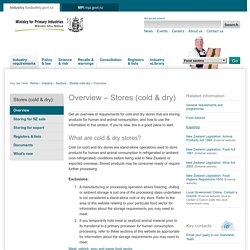
If you’re new, this is a good place to start. What are cold & dry stores? Cold (or cool) and dry stores are stand-alone operations used to store products for human and animal consumption in refrigerated or ambient (non-refrigerated) conditions before being sold in New Zealand or exported overseas. Stored products may be consumer-ready or require further processing. Exclusions: A manufacturing or processing operation where freezing, chilling or ambient storage is just one of the processing steps undertaken is not considered a stand-alone cold or dry store.
Meat, ostrich, emu and game food sector. AsureQuality. Technical rules. MPI - Ministry for Primary Industries. A New Zealand Government Department. AP4 Registration of Risk Management Programme. MPI - Ministry for Primary Industries. A New Zealand Government Department. Developing your Risk Management Programme (RMP), MPI, food. Use the information here to develop an RMP and get your application ready to send to MPI.
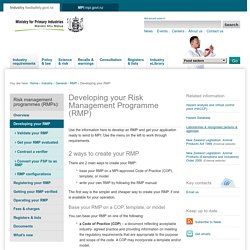
Use the menu on the left to work through requirements. 2 ways to create your RMP. Bee products - Code of practice. Certification FAQs — BioGro NZ. Can I transfer my organic certification from another certifier or programme?
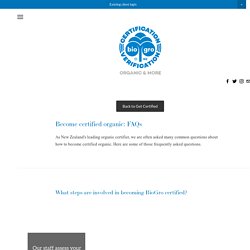
Yes. We will continue your organic certification at the same point you were at with your previous certifier. Contact us to find out more. Convert your FSP to an RMP, MAF, food. Bee cop part 1. Labelling guide0 all nzfsa v2 labelling guide web. Recallriskanalysisguide. Developing your food recall plan, Recalls & warnings, MAF, food. Conducting a food recall, Recalls & warnings, MAF, food. If you need to conduct a food recall, follow this quick checklist: First, seek advice from a MPI Food Act Officer by phoning 0800 00 83 33 Follow your recall plan.
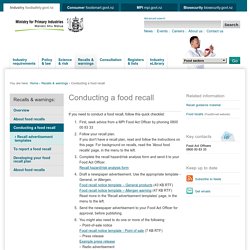
If you don't have a recall plan, read and follow the instructions on this page. For background on recalls, read the 'About food recalls' page, in the menu to the left. Complete the recall hazard/risk analysis form and send it to your Food Act Officer. Recall hazard/risk analysis form Draft a newspaper advertisement. Recall guidance material. Processing and selling bee products in New Zealand. If you process honey and bee products for sale in New Zealand, find out about the requirements under the Food Act 1981, labelling and limits on exporting.

Operating under the Food Act 1981 Bee products, including honey, that are produced for domestic consumption, may be produced under the requirements of the Food Act 1981. 2014 guide to meet honey labelling requirements. Food Standards Code from 1 March 2016. Page Content An audit of the legal efficacy of the Code was conducted following a decision of the New South Wales Supreme Court in 2009.
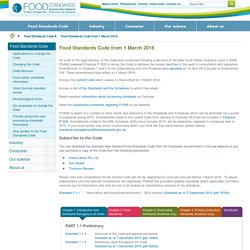
FSANZ prepared Proposal P1025 to revise the Code to address the issues identified in the audit in consultation with regulators. Amendments to Chapters 1 and 2 of the Code arising from this Proposal were gazetted on 10 April 2015 as part of Amendment 154. These amendments take effect on 1 March 2016. Access the current Code which ceases to have effect on 1 March 2016. FSANZ is aware of a number of minor errors and omissions in the Standards and Schedules which will be amended via a series of proposals during 2015. Australia New Zealand Food Standards Code – Standard 1.2.4 – Information requirements – statement of ingredients. Standard 1.2.4 Information requirements – statement of ingredients Note 1 This instrument is a standard under the Food Standards Australia New Zealand Act 1991 (Cth).
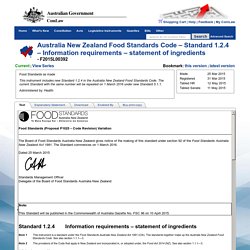
The standards together make up the Australia New Zealand Food Standards Code. See also section 1.1.1—3. Note 2 The provisions of the Code that apply in New Zealand are incorporated in, or adopted under, the Food Act 2014 (NZ). Hill Laboratories - Honey Testing - Honey Testing, Honey Tests, manuka honey. Food Composition Database: The Concise New Zealand Food Composition Tables.
The Concise New Zealand Food Composition Tables provide information from the New Zealand Food Composition Database in PDF and Microsoft Office Excel file format.

The Concise Tables contain data on key nutrients for commonly consumed foods and are ideal for quick reference. The latest version - The Concise New Zealand Food Composition Tables 11th Edition 2014 - contains data for 36 components for 1013 foods. Interim labelling guide manuka honey. Food Standards Code from 1 March 2016. Honey bee products roadmap. Getting Ready 1. Getting Ready 1 is the preschool level of the curriculum.
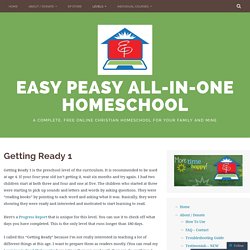
It is recommended to be used at age 4. If your four-year old isn’t getting it, wait six months and try again. I had two children start at both three and four and one at five. The children who started at three were starting to pick up sounds and letters and words by asking questions. They were “reading books” by pointing to each word and asking what it was. Here’s a Progress Report that is unique for this level. I called this “Getting Ready” because I’m not really interested in teaching a lot of different things at this age. Your child can watch the videos independently, but they are little and are going to need a parent or older sibling to guide and help. This level is split into two parts, learning the alphabet and their phonetic sounds, and then beginning to learn to read with sight words. The alphabet stories from this level are also on youtube and have been put on pdf, girl version, boy version.
Materials: iPad Basics. Wild Things 124: Bugs Up Close. Mystery: Impossible!
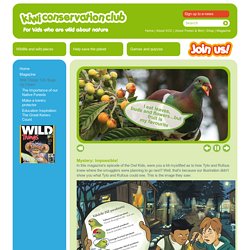
In this magazine's episode of the Owl Kids, were you a bit mystified as to how Tyto and Rufous knew where the smugglers were planning to go next? Well, that's because our illustration didn't show you what Tyto and Rufous could see. This is the image they saw: Where Are They Now? (Update on the family in the film) It’s been one year since Class Dismissed premiered and even longer since we ended principle photography.
Lately a lot of people have been asking us how the family featured in the film are doing. The most common question we get asked about them is: “ Are they still homeschooling and what are they doing now?” Good questions for sure, so recently, we reached out to them and they were kind enough to give us the following update. “Yes we are still homeschooling,” Rachel told us, “But we are are rarely home!” INTRAWEB CAD LIMBURG 2008. The Montessori Great Lesson Page. My name is Barbara Dubinsky. I have been involved in the Montessori community for 30 years, through my own children, as an assistant, administrator, Lower Elementary teacher and now as a trainer.
Fourteen years ago, I joined the movement of Montessori into the public schools - a most exciting expansion. I teach at a magnet school in Charlotte, NC. It is both challenging and ever so rewarding at the same time. Our school is given much freedom to do what we need to do as Montessorians; we have fought fiercely to have this freedom and have proven that what we do is the best system for children. For many years, as a member of the Montessori Educational Listserv ( listserv@aol.com - write Subscribe Montessori-L in the body of the message) I saw many questions about the Great Lessons themselves and how to keep the work of the Great Lessons active in the class. Homework Sheets. Organics, MAF, food. FSG Limited Liability Partnerships. Interim labelling guide manuka honey.